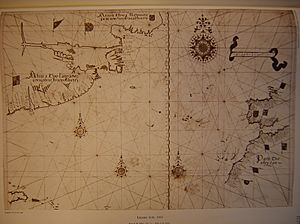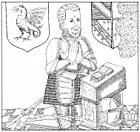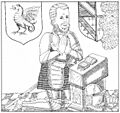Newfoundland expedition (1585) facts for kids
Quick facts for kids Newfoundland Expedition (1585) |
|||||||
|---|---|---|---|---|---|---|---|
| Part of the Anglo–Spanish War | |||||||
 A 1563 map of the North Atlantic with Newfoundland top center |
|||||||
|
|||||||
| Belligerents | |||||||
| Commanders and leaders | |||||||
| Unknown | Bernard Drake | ||||||
| Strength | |||||||
| Numerous Spanish & Portuguese ships | 10 ships | ||||||
| Casualties and losses | |||||||
| 23 ships captured, burned, or sunk ~600 prisoners |
Light | ||||||
The Newfoundland Expedition, also called Bernard Drake's Newfoundland Expedition, was an important sea journey by the English navy. It happened in the North Atlantic Ocean during the summer and autumn of 1585. This was at the start of the Anglo-Spanish War. The main fighting took place near the Grand Banks, which are off the coast of what is now Newfoundland.
The main goal of this expedition was to capture the fishing fleets of Spain and Portugal. The expedition was a huge success for England, both militarily and financially. It almost completely removed Spanish and Portuguese ships from these important fishing waters. This raid also had big effects on England's plans to expand and settle in new lands.
Contents
Why the Expedition Happened
War Begins with Spain
War had already been declared by Philip II of Spain, the King of Spain. This happened after Queen Elizabeth I of England signed the Treaty of Nonsuch. In this treaty, she promised to support the Protestant Dutch rebels who were fighting against Spanish rule.
On May 26, 1585, Spain stopped all English ships in Bilbao harbor. Soon, this ban spread across all of Spain. An English merchant ship called the Primrose managed to fight its way out and brought this news to London. The English were very angry. In response, Queen Elizabeth allowed many privateers (private ships allowed to attack enemy ships) to sail. She also took steps to protect other English merchant ships from being caught in Spain.
At the same time, Queen Elizabeth, through her advisor Francis Walsingham, ordered Sir Francis Drake to lead an expedition. This mission was to attack the Spanish New World as a kind of preemptive strike (an attack made to prevent an enemy attack).
English Claims in Newfoundland
Sir Humphrey Gilbert had landed in St. John's, Newfoundland, in August 1583. He officially claimed Newfoundland for England. He had special permission letters from the Queen to do this.
Bernard Drake was a distant relative of Sir Francis Drake. He became involved with Gilbert through other family members like Richard Grenville and Walter Raleigh. In 1585, Bernard Drake joined Raleigh and Gilbert's brother, John. They were involved in activities related to the Roanoke Colony in what is now North Carolina.
Planning the Mission
On June 10, 1585, Walter Raleigh was given permission by the Privy Council (a group of royal advisors) to prepare ships. These ships were for a trip to the Newfoundland fishing grounds. The expedition had two main goals:
- To warn English fishing boats there not to sell their fish directly to Spain or Portugal. Trade with these countries was already common.
- To capture any ships belonging to the King of Spain that they could find.
Orders to lead these expeditions were given to Carew Raleigh and Bernard Drake on June 20. Around June 27, Bernard Drake was specifically told to start his expedition against the Newfoundland fisheries. They decided not to go on a privateering trip to the West Indies on the way to Roanoke. Sir Richard Grenville had already left Plymouth in April to settle a colony there.
Drake's Journey and Attacks
Bernard Drake left Plymouth for Newfoundland in July 1585. He had a fleet of ten ships, including his main ship, the Golden Riall. Many of these ships were paid for by investors. These investors hoped to get a share of any valuable goods captured. The mission quickly found success. They captured a large Portuguese ship filled with Brazilian sugar and other goods.
Drake arrived off Newfoundland in mid-August. He landed at Saint John's, which helped England confirm its claim over the area. St. John's became a base for his operations. His ships could get supplies and fresh water there. While in St. John's, he warned the English fishermen about the danger of sailing directly to markets in Spain and Portugal. Instead of going home, many English fishermen joined Drake's fleet. His group of ships soon grew to ten, and many of them were armed.
As the English settled in, they began to stop, capture, and take goods from many Spanish and Portuguese fishing ships. Some of these ships were even burned. A few armed flyboats (fast, light ships) that were protecting the fishing vessels met the same fate. These small armed ships were no match for the heavily armed English ships. Most of them either fled or were captured.
As news of the raid spread, Spanish fishing ships started to use the island's south coast more often. This was mainly around the Avalon peninsula, away from where the English were strong. By the end of September, Drake had cleared this area of Spanish and Portuguese ships. He then sent some of his own ships back to England, taking the captured ships with them.
Drake's force also attacked a Spanish whaling and fishing base on the Burin Peninsula. They captured or burned all the supplies there. Other smaller locations in Placentia Bay were also destroyed. Soon, it became harder to find ships to capture in the region. Drake then met up with George Raymond, another person connected to Raleigh, who was sailing the Red Lion. Raymond had sailed with Richard Grenville on the way to Roanoke Island.
Leaving Newfoundland, Drake's force then headed to the Azores. They hoped to capture Spanish ships coming from the West Indies. They had more success there, capturing ships with valuable goods like sugar, wine, and ivory. They even captured a French ship carrying some gold. As sickness began to spread among his crew, Drake's ships headed home. However, they ran into a storm that caused them to lose two of their captured ships.
In total, Drake's expedition probably captured more than twenty ships. But not all of them made it safely back to England. Many of the captured ships were sunk in storms, burned, or destroyed in battle.
What Happened Next
Success and Rewards
The expedition was very successful and profitable. It also greatly harmed the Spanish navy and merchant ships. It took away about 60,000 quintals (or 3,000 tons) of dried fish. This fish was very important for feeding crews on long ocean voyages.
About 600 Spanish and Portuguese prisoners were taken. Many were brought back to England and held there. This was in return for Spain doing the same to English ships in Spain. Estimates of how much the captured goods were worth vary. But the trip likely made a profit of at least 600 percent. As their share, Drake and his oldest son, John, were given four of the most valuable ships by Raleigh and Sir John Gilbert.
On January 9, 1586, Queen Elizabeth knighted Bernard Drake at Greenwich. This was to honor his great success. A couple of months later, the Portuguese prisoners who had survived were put on trial in Exeter. The charge was likely mutiny (rebelling against authority). The trial took place during the famous Black Assize of Exeter on March 14, 1586, at Exeter Castle. Sadly, many of the people involved in the trial, including the Portuguese prisoners, became sick and died within a few weeks. Bernard Drake also died in Crediton on April 10, 1586, and was buried two days later. His son John inherited the profits from the Newfoundland voyage.
Long-Term Effects
As a safety measure, the Spanish government forbade its ships from sailing to Newfoundland the following year. After the defeat of the Spanish armada (a large Spanish fleet) later on, Spain lost many ships. Also, English activity in the region increased over the next century. Because of this, Spanish activity in Newfoundland greatly decreased.
Drake's raid caused serious and lasting damage to the Spanish and Portuguese fishing industries. The Portuguese fishery, in particular, never fully recovered. Because of Drake's huge success and its impact, this expedition helped England and France (Basque) become the main powers in North America. This then led to more colonial settlement in the early 1600s.
Images for kids




